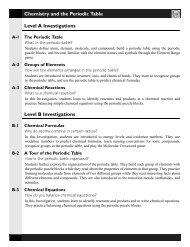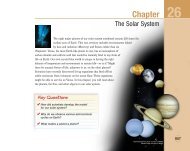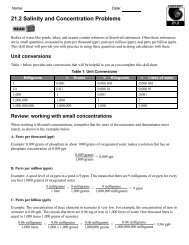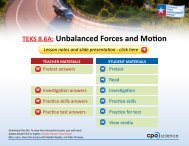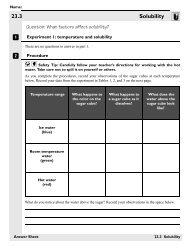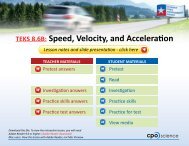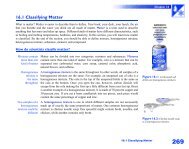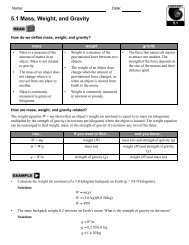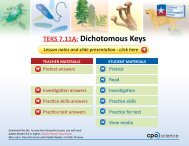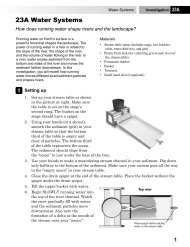Sample Teacher Material - CPO Science
Sample Teacher Material - CPO Science
Sample Teacher Material - CPO Science
You also want an ePaper? Increase the reach of your titles
YUMPU automatically turns print PDFs into web optimized ePapers that Google loves.
Force and MotionReference GuideEquipment SetupCar & Ramp . . . . . . . . . . . . . . . . . . . . . . . . . . . . . . . . . . . . . . . . . . . . . . . . . . . . . . . . . . . . . . . .1Investigation GuidesA-1 Time and Distance . . . . . . . . . . . . . . . . . . . . . . . . . . . . . . . . . . . . . . . . . . . . . . . . . . . . . . . . . . . . . . . . 3A-2 Investigations and Experiments . . . . . . . . . . . . . . . . . . . . . . . . . . . . . . . . . . . . . . . . . . . . . . . . . . . . . . 9A-3 Speed . . . . . . . . . . . . . . . . . . . . . . . . . . . . . . . . . . . . . . . . . . . . . . . . . . . . . . . . . . . . . . . . . . . . . . . . . 13A-4 Describing Motion . . . . . . . . . . . . . . . . . . . . . . . . . . . . . . . . . . . . . . . . . . . . . . . . . . . . . . . . . . . . . . . 17A-5 Gravity . . . . . . . . . . . . . . . . . . . . . . . . . . . . . . . . . . . . . . . . . . . . . . . . . . . . . . . . . . . . . . . . . . . . . . . . 21B-1 Time and Distance . . . . . . . . . . . . . . . . . . . . . . . . . . . . . . . . . . . . . . . . . . . . . . . . . . . . . . . . . . . . . . . 25B-2 Investigating Speed . . . . . . . . . . . . . . . . . . . . . . . . . . . . . . . . . . . . . . . . . . . . . . . . . . . . . . . . . . . . . . . 31B-3 Using a Scientific Model to Predict Speed . . . . . . . . . . . . . . . . . . . . . . . . . . . . . . . . . . . . . . . . . . . . . 37B-4 Position and Time . . . . . . . . . . . . . . . . . . . . . . . . . . . . . . . . . . . . . . . . . . . . . . . . . . . . . . . . . . . . . . . 41Car and Ramp
Investigation Guides (continued)B-5 Acceleration . . . . . . . . . . . . . . . . . . . . . . . . . . . . . . . . . . . . . . . . . . . . . . . . . . . . . . . . . . . . . . . . . . . . 45B-6 Force, Mass, and Acceleration . . . . . . . . . . . . . . . . . . . . . . . . . . . . . . . . . . . . . . . . . . . . . . . . . . . . . . 49B-7 Weight, Gravity, and Friction . . . . . . . . . . . . . . . . . . . . . . . . . . . . . . . . . . . . . . . . . . . . . . . . . . . . . . 55B-8 Equilibrium, Action, and Reaction . . . . . . . . . . . . . . . . . . . . . . . . . . . . . . . . . . . . . . . . . . . . . . . . . . . 59C-1 Uniform Accelerated Motion . . . . . . . . . . . . . . . . . . . . . . . . . . . . . . . . . . . . . . . . . . . . . . . . . . . . . . 63C-2 Newton’s Second Law and Friction . . . . . . . . . . . . . . . . . . . . . . . . . . . . . . . . . . . . . . . . . . . . . . . . . 69C-3 The Physics of the Inclined Plane . . . . . . . . . . . . . . . . . . . . . . . . . . . . . . . . . . . . . . . . . . . . . . . . . . . 75Car and Ramp
Level BB-7 Weight, Gravity, and FrictionKey Question: How does increasing the mass of the car affect itsacceleration?According to physics, heavier objects should fall at the same speed as lighter ones. In the real world,friction often creates proportionally more resistance on light objects than on heavier objects. In thisInvestigation, students carefully analyze how changing a car’s mass affects the speed of the car rollingdownhill. They use the experience to discuss friction, the difference between mass and weight, andhow to use percent change as a tool for assessing the relevance of changes in variables.PreparationStudents should understand the concepts of speed, force, andacceleration before beginning this Investigation. You should alsointroduce gravity and friction before the Investigation.Gravity is a force that pulls every mass toward every other mass. Sincethe Earth is the biggest mass around, we experience gravity as a forcethat pulls everything toward the center of the Earth. We call the force ofgravity weight. Using Newton’s second law, we calculate an object’sweight and acceleration in free fall.Friction is a catchall word for all forces that act against motion. Frictioncan come from rubbing, sliding, fluid motion, air motion, and othersituations. The force of friction always opposes the motion thatproduces the friction.Setup and <strong>Material</strong>sThe InvestigationTimeLeadingQuestionsLearningGoalsOne class period• How is motion affected by friction?• Do heavier objects fall faster than lighterobjects?• What is friction?In this Investigation, students will:• Describe the effects of friction.• Explain why in real life, heavier objects oftenfall faster than lighter objects, even though thisappears to contradict the laws of physics.• Evaluate the percent change in a variable andcorrelate this to an observed effect.B-7Weight, Gravity, and FrictionStudents work in groups of four at tables.Each group should have:• Car and ramp, physics stand, <strong>CPO</strong> timer with two photogates, set ofweights.• Spring scale for measuring force, tape measure, balance for measuringmass, graph paper, pencils, rulerEach student should have:• Copy of the Investigation and answer sheetsKey Vocabularyforce, weight, mass, gravity, friction, percent change55
Investigation AnswersInvestigation PageA1b. It is hard to tell just by looking if adding weightschanges the speed. The time does seem to get a littleshorter but not by much.B<strong>Sample</strong> data (table shown on page 2):Mass(g)DistancefromA to B(cm)TimefromA to B(sec)Speed(cm/sec)330 20 0.1475 135.6520 20 0.1425 140.4710 20 0.1402 142.7900 20 0.1391 143.8B-7 Weight, Gravity, and FrictionABQuestion: How does increasing the mass of the car affect its acceleration?In this Investigation, you will:1. Explore how added weight affects a car’s acceleration.2. Discuss and learn whether or not heavier objects fall faster than lighter objects.3. Investigate friction and how friction affects motion.So far, you have learned that the car accelerates as it moves down the ramp. That is, its speed increasesover time. In the last Investigation, you explored what happened to the acceleration of a car when moreforce was applied to it.The force that you used in the last Investigation wasgravity. Gravity pulls all objects toward the center ofEarth with a force we call weight. The more mass anobject has, the greater its weight. If you increase theweight of the car, how will acceleration be affected?Do heavier objects fall faster than lighter ones?Do you think adding weights to the car will change its speed?a. You can add up to three weights to the car for this experiment.Weights are attached to the top of the car using the wing nut.b. Roll a car down the ramp with different amounts of weight andwatch it, without using photogates. Does the change in mass seem tomake a difference in the speed?Safety tip: Keep your fingers away from the ramp when the car is rolling. Especially,keep your hands away from the bottom of the ramp until the car stops.Testing your hypothesisIt is difficult to know for sure that the car is goingfaster (or not) without making measurements. Set upthe car and ramp with two photogates. The photogatesshould be about 20 centimeters apart. Set the angle atthe seventh hole from the bottom of the stand.You will want to measure the mass of the car with noweights, and with one, two, and three weights. On thedata table, record the masses and the speeds at whichthe car rolled between the two photogates.B-7156Force and Motion
Investigation Page Investigation AnswersCDGraphing and analyzing the dataa. Make a graph of speed vs. mass using your data.b. Which is the dependent variable? On which axis does it go?c. Which is the independent variable? On which axis does it go?d. From your graph, what can you say about the effect of increasing mass on the speed of the car? Did thespeed change by a lot or by a little? Did the mass change by a lot or a little?FrictionTry the following experiment. Take a steel weight and a flat sheet of paper. Drop them both and thesteel weight will hit the ground before the paper every time. Next, crumple the sheet of paper and dothe experiment over. They should hit the ground about the same time.a. The crumpled paper has the same weight as the flat sheet of paper. What is the explanation for why thecrumpled sheet fell fast and the flat sheet fell slowly?b. The car has friction, even though the wheels have ball bearings. Can you think of a way to increase thefriction in the car? See if you can create enough friction so the car does not accelerate, but keeps thesame speed from one photogate to the next.EMass(g)Thinking about the resultsMass and Speed DataDistance fromA to B (cm)Time fromA to B (sec)Speed(cm/sec)Suppose you have a jar of 1,000 marbles. If you lose one marble, it is hard to notice because 1 out of1,000 is a small change. If you only had 5 marbles in the jar, you would immediately notice if one weremissing because 1 out of 5 is a much larger change.a. We often express change in percent. One out of 5 is a change of 20 percent (1/5 × 100%). The percentchange is the change divided by what you started with, times 100 percent. Calculate the percent changefor the weight experiment.b. Does the percent change have anything to do with how much the speed changed as you added thesecond and third weights?B-7C3a. Graph right:3b. The dependent variable isspeed. It goes on the y-axis.3c. The independent variable ismass, and it goes on the x-axis.3d. The speed changed only asmall amount, but themass changed a lot.D4a. The flat paper floats on the air, but the crumpledpiece of paper doesn’t float as much.4b. We increased friction on the car by using string toprevent the wheels from turning. The speed was stillnot constant because the car jerked a bit as it wentdown the ramp. However, the car did not speed up.E5a. We also calculated percent change in speed. Theresults are 3.5%, 1.6%, and 0.8%.5b. Although the effect of weight on speed was small, asthe percent change in mass went down, so did thepercent change in speed.2Investigation B-7 Weight, Gravity, and Friction57
Assessment Answer Key1. Mass is the amount of matter an object has. Mass is constantand is measured in kilograms. Weight is the force created bygravity on objects. The weight of an object depends on its massand is measured in newtons.2. 3.0 feet/sec - 2.5 feet/sec = 0.5 feet/sec(0.5 feet/sec ÷ 2.5 feet/sec) × 100 = 20% increase in speed.3. Graph of data:The data are inconclusive. There seems to be norelationship between weight and speed. The problem doesnot state the procedures that the students followed whenpushing off from the top of the hill. Maybe some of themhad a running start and others did not.58Investigation B-7 Weight, Gravity, and Friction
Curriculum Resource Guide: Car and RampCredits<strong>CPO</strong> <strong>Science</strong> Curriculum Development TeamAuthor and President: Thomas Hsu, Ph.DVice Presidents: Thomas Narro and Lynda PennellWriters: Scott Eddleman, Mary Beth Abel, Lainie Ives, Erik Benton andPatsy DeCosterGraphic Artists: Bruce Holloway and Polly CrismanCurriculum ContributorsDavid Bliss and David LampTechnical ConsultantsTracy Morrow and Julie DaltonCurriculum Resource Guide: Car and RampCopyright 2002 Cambridge Physics OutletISBN 1-58892-046-12 3 4 5 6 7 8 9 - QWE - 05 04 03All rights reserved. No part of this work may be reproduced or transmitted in any form or by an means,electronic or mechanical, including photocopying and recording, or by any information store or retrievalsystem, without permission in writing. For permission and other rights under this copyright, please contact:Cambridge Physics Outlet26 Howley Street,Peabody, MA 01960(800) 932-5227http://www. cpo.comPrinted and Bound in the United States of America



